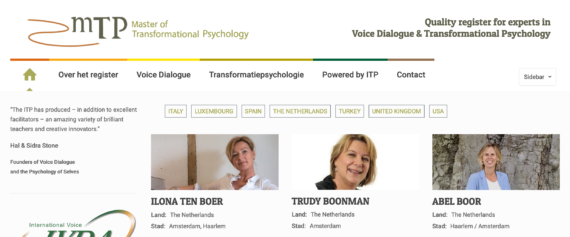Voice Dialogue is a method intended for training in self-awareness and transformation of consciousness, but equally valid as an important therapeutic tool. Furthermore, the dialogue method is extremely useful for relationships. For actors it is an excellent expedient to examine and experience the energy patterns from which “characters” and roles emerge.
Our Selves
Voice Dialogue is a method to come into dialogue with our inner voices. These voices belong to the various parts of our personality: our selves. Each of these selves has its own way of thinking, feeling, behaviour and observation. Often we identify with one or more sub-personalities, our so-called “primary selves”, while other parts of us try to let themselves be heard in vain. In Voice Dialogue the various selves are invited to speak freely, to manifest themselves with all their energy. Freely means without interference of the ego, which often identifies itself with critical sub-personalities, like the “controller” and the “critic”.
Energy work
We emphasize that Voice Dialogue is energy work. Basically, the selves are energy patterns which we have developed throughout our lives, and as such are of physical, emotional, mental and spiritual nature.
Vulnerability
Our definition of consciousness is: the awareness and experience of energy patterns. An important base for the construction of the personality is the polarity of vulnerability and power. Between these two poles we live our individual life and relationships. The discovery of our vulnerability is often the start of the transformational process.
Aware Ego
Voice Dialogue is a simple, highly elegant method. Theoretically founded by Jung, it was fostered by trends like Psychodrama, Gestalt, Transactional Analysis and Psychosynthesis, and influences can be traced back to Greek philosophy, and the teachings of Aurobindo and Gurdjieff. With Voice Dialogue one can go as ‘deep’ as one likes, but also as ‘high’ as one can reach, as ‘low’ and as ‘far’ as one dares. It is the exploration of our inner space, in which both heaven and earth have their place.
The ultimate goal of the training is to get to know ourselves in all dimensions, to acquire more possibilities of choice from an increasingly aware ego. As a result, the ensuing shift in our energy patterns also changes consciousness. This changing view of ourselves alters our possibilities for relationships and our place in the world.
How does Voice Dialogue work?
In Voice Dialogue the various selves are invited to speak freely, to manifest themselves with all their energy. Freely means without interference of the ego, which often identifies itself with critical subpersonalities, like the “controller” and the “critic”.
With Voice Dialogue one can go as ‘deep’ as one likes, but also as ‘high’ as one can reach, as ‘low’ and as ‘far’ as one dares. It is the exploration of our inner space, in which both heaven and earth have their place. The ultimate goal of the training is to get to know ourselves in all dimensions, to acquire more possibilities of choice from an increasingly aware ego.
As a result, the ensuing shift in our energy patterns also changes consciousness. This changing view of ourselves alters our possibilities for relationships and our place in the world.
For whom?
For anyone and everyone who is interested in self-development and the development of others. It is for those who are concerned with getting to know the content of their own character as well as those who are tasked with helping others do the same.
Because of its practical usability and clear theoretical framework Voice Dialogue is suited for both individuals and practitioners who are new to such as a method as well as trained experts who are looking for new and practicable ways of helping and guiding their patients.
Whomever you are: Voice Dialogue is a deepening and interesting practice to add to your toolkit on the way of self-knowledge.
How will you benefit?
If you practice Voice Dialogue with a skilled facilitator you will start to see improvements rapidly. Amongst the benefits of this method are the following:
- Insight into your behaviour, feelings and choices.
- Find out which selves are running your life, relationships and career and which selves deserve some more attention.
- Develop the ability to make conscious and free choices by becoming free from your old habits.
- Gain a more centred and inclusive sense of who you are, through embracing various and opposite sides of your personality.
- Become aware of your whole humanity – be it rational, emotional, material, spiritual, pleasing, parental or childlike.
- Learn from your relationships: the way you bond with and judge others will teach you many things about who you are.
- Improve your romantic relationships by recognising when you are stuck in old patterns and become able to navigate these before your relationships fall apart.
- Greater ability to face the challenges of parenting. You’ll be more aware of the emerging selves in your child and the way your personality determines the personality and behaviour of your child.
- Develop a sensitivity towards the energies of yourselves and others. Learn to use these energies more consciously and set boundaries far more easily.
Voice Dialogue: The Method
The theoretical framework for Voice Dialogue was named the Psychology of Selves by the movement’s founders Hal and Sidra Stone. The name refers to the idea that our personalities are not ‘one true’ self, but many different selves – also called subpersonalities – each of which have their own lives, desires and needs.
The objective of Voice Dialogue is to study how these selves operate within each of us, our relationships and our decision-making processes. In short: through dialogue we wish to learn how the various selves relate to the evolution of our consciousness and the lives we lead.
In the following points we’ll lead you through a short introduction into some of the most important theoretical concepts in the Psychology of Selves and Voice Dialogue: the consciousness model, the inner critic, the unconscious and the bonding patterns.
Consciousness model
In Voice Dialogue we think of consciousness as the awareness ánd experience of energy patterns. We divide consciousness into three levels.
- 1. Awareness
- 2. Experience of Energy Patterns
- 3. Aware Ego Process
1. Awareness
Awareness is the state where you can witnessing yourself and your life without judgement or evaluation.
2. The experience of Energy Patterns or subpersonalities
These patterns represent the subpersonalities within us. The subpersonalities are the parts that make up our personality. They are not only mental, but they consist of energy and are connected to our body. Every subpersonality has its own will, its thoughts and feelings, and its own voice.
There are many different selves: Controller, Beach bum, Perfectionist, Letting go, Pusher, Natural flow, Responsibility, Pleaser, Selfish part and Vulnerability to name a few.
We divide the selves into categories and distinguish primary selves, disowned selves and undeveloped selves. A primary self is a part of the personality that has been strongly developed in order to help the person to survive psychologically and sometimes even physically. It develops at an early age and has a function of defending our vulnerability. Opposite the primary self we find the disowned self. That is a part of the personality that is not recognised and accepted by the person and pushed away into the unconscious. Similar aspects of other people are judged. The undeveloped self is a part of the personality that isn’t developed yet and becomes visible whenever life changes are there, e.g. when people become mother or father, then this part will develop.
In working with our inner selves, the concept of polarity is important to understand. The primary selves are linked with disowned selves as polarities. If you have a well-developed primary self, this usually means that on the opposite side of that you can find the disowned self.
Let’s say that your primary self is a well-developed pleaser; you do a lot of the things you do to please others.. You can imagine that people who generally like to please people, are not very well equipped to take their own space or to follow their selfish needs, at their own cost. Because they’ve learned to please at a young age, they’ve never learned to be selfish. So the Selfish part is the disowned self.
The primary selves do a good job in protecting the vulnerability. We are often unconsciously vulnerable under our primary selves. According to Sidra Stone Vulnerability is the window into our soul. It is the gateway to connection and intimacy. It has to aspects:
- The quality of openness, innocence and beauty.
- Defencelessness against hurt and abuse.
We’ve developed in such a way that we avoid being defenceless, as a protection against hurt and abuse.
Through Voice Dialogue you’ll learn to become aware of that vulnerability and how to take care of it.
3. The Aware Ego process
The aware ego is the choice maker within the psyche. It receives information both from the awareness level and from the energy patterns (subpersonalities). When developed through the Voice Dialogue method it replaces the operating ego, that is a combination of primary selves. The Aware Ego process is a dynamic and changing process. It encompasses both the awareness level and the experience of energy, since both are essential to making progress in the process of consciousness.
It is therefore an essential concept in Voice Dialogue. The Aware Ego is the middle position between the polar opposites made up by the primary and disowned selves.
Concepts
Primary Selves
The primary selves are the parts of the personality that have been strongly developed in order to help the person to survive psychologically and sometimes even physically. They develop form an early age onwards and have the function of defending our vulnerability
Disowned Selves
A part of the personality that is not recognised and accepted by the person and pushed away in the unconscious. Similar aspects of other people are judged.
Undeveloped Selves
The undeveloped selves are the parts of the personality that haven’t developed yet and become visible whenever life changes are there, e.g. when people become mother or father, then this part will develop.
Polarities
Polarity is an important concept in the working of these inner selves: The Primary selves are linked with disowned selves as polarities. If you have a well-developed primary self, this usually means that on the opposite side of that you can find the disowned self that hasn’t got so much attention because of it.
Let’s say that your primary self is a well developed pleaser; you do a lot of the things you do to please others. This is then your primary self. You can imagine that people who generally like to please people, are not very well equipped to take their own space or to follow their selfish needs, at their own cost. Because they’ve learned to please at a young age, they’ve never learned to be selfish. So the Selfish part is the disowned self.
Vulnerability
According to Sidra Stone Vulnerability is the window into our soul. It is the gateway to connection and intimacy. It has to aspects:
- The quality of openness, innocence and beauty.
- Defenselessness against hurt and abuse.
We are often unconsciously vulnerable under our primary selves. We’ve developed in such a way that we avoid being defenseless, as a protection against hurt and abuse.
Through Voice Dialogue you’ll learn to become aware of that vulnerability and how to take care of it.
Aware Ego Process
The Aware Ego process is a dynamic and changing process. It encompasses both the awareness level and the experience of energy, since both are essential to making progress in the process of consciousness.
It is therefore an essential concept in Voice Dialogue. The Aware Ego is the middle position between the polar opposites made up by the primary and disowned selves.
Inner Critic
An important part of Voice Dialogue, and quite a liberating one at that, is working with the Inner Critic. We all have it: that nagging voice inside our heads telling us we’re not good enough in one way or another. Whether it’s our looks, what we create or our relationships – somehow it will always find something to criticize you.
Voice Dialogue is an excellent method to make contact with the Inner critic and to transform it from your worst enemy into a worthy ally that can help you whenever you need it.
The Unconscious
In Voice Dialogue we do not simply work with what is present to consciousness. We also put emphasis on working with materials and energy patterns that lie behind the control of the operating ego: the subconscious.
By working with (day)dreams we come to find that we are not alone in our journey. The goal of working with the subconscious is to awaken our inner teacher, or as Hal and Sidra Stone put it:
“In Voice Dialogue it is clear that there is in the universe, and within each of us, a deeper intelligence that can be ignited as we begin our journey of personal discovery. Once this intelligence is activated it has the possibility of becoming an always available friend and teacher to us.”
Relationships: Bonding Patterns
There is a natural ebb and flow in relationships, a movement between intimacy and distance. When we take a closer look at these movements we can see that there are certain predictable patterns in all of them.
These so-called bonding patterns are automatic parent-child interactions between the ‘parent side’ of one person and the ‘child side’ of the other person. We distinguish positive and negative bonding patterns. These interactions occur between two people in a variety of different contexts of relation, work, and family.
In Voice Dialogue we use a technique called ‘Mapping’ to create a map of the patterns in your relationships that you are unaware of and have a negative impact on your relationship. Having such a map gives you the opportunity to take different paths and create more healthy, free and positive bonding patterns.
How do you work with Voice Dialogue?
Voice Dialogue isn’t just a theoretical framework for thinking about your selves. It is a highly practical method for contact and intimacy with those selves within you.
There are several ways you can experience the way Voice Dialogue works.
Personal Coaching or Psychotherapy
In the beginning it will mainly be through personal coaching or Psychotherapy with an experienced facilitator, to get a hang of how this method works for you.
In such conversations – they are dialogues, not monologues by you – you’ll move through the space and energy patterns that appear within you, whilst the facilitator not just listens but is also carefully aware of his or her patterns and voices that appear.
Training to be a facilitator
If you’re interested in deeper immersion in the method you can follow one- or two-year-training by an experienced facilitator. You’ll learn all about Voice Dialogue and how you can help others by facilitating dialogue with their selves.
Of course this is a useful method for healthcare professionals or coaches who are looking to broaden their toolkits.
The Origins of Voice Dialogue
We can trace the origins of Voice Dialogue along a long line of psychological and scientific predecessors, who were all in one form or another interested in the inner workings of the human psyche. What follows is a concise history and its most important figures.
And so it begins…
Our little history starts about three hundred years ago. Phenomena such as prayer healing (Gassner, 1727 – 1779) and healing through magnetism (Mesmer, 1734 – 1815) received a lot of attention from the people and scientists alike. In the 18th and 19th century hypnosis was (re)discovered to be a gateway to the psyche.
They tried to understand and explain the hypnotic phenomena. Not only was there a dualism, conscious and unconscious, but it was also assumed that the psyche consisted of several layers. Terms such as multiplicity of the psyche came into vogue. There was also talk of both conscious and unconscious subpersonalities.
Psychic Phenomena
In the nineteenth century, attempts were made to describe the many phenomena of the human psyche which were difficult to understand, in a larger context. Bastien (1826-1905) was an ethnologist at this time and was the first to describe the phenomenon of archetypes. People were searching for the world soul in this period. Bastien attributed the phenomenon of similar deeper layers in the psyche to this world soul. Later, Jung adopted the idea of the archetype as a deeper layer in the psyche of man.
Psychology as a science
With Wundt (1842-1910), psychology then developed into a science. He set up a laboratory where he tried to investigate consciousness through introspection. He expected to discover a structure in this.
The French psychiatrist Janet (1859-1947) described the mechanism of the parts of the personality which remained unconscious, mainly in “hysterical” patients. He called this dissociation. In his view, this occurs due to a lack of integration of the personal consciousness. He found that these separate states of consciousness function more or less independently of each other. He attributed this phenomenon mainly to intense emotions during traumatic events which could not be processed. These emotional memories then end up in the unconscious. The dissociated memory remains active at an unconscious level and causes complaints. At the time, psychiatrists focused mainly on hysterical patients.
The plurality of the person
Freud (1856-1939), as a neurologist, also examined patients with what was then called “hysteria” and neurosis and explained, in line with the prevailing views at the time, that these problems stemmed from the unconscious. He built further on the stratification of the soul and made a distinction between the Id, Ego and Superego. This tripartite division can also be seen as plurality. Freud described the internal struggle in man that results from this.
William James (1842-1910) described a wide range of subjects explored including hypnosis and religious experiences. He launched the concept of stream of consciousness, drawing inspiration from Buddhism. Like Wundt, James believed that introspection was a means to self-knowledge. His descriptions of the ‘Self’ and particularly his term ‘social selves’ are very close to the personality parts in Voice Dialogue.
The archetypal father: C.G. Jung
Jung (1875-1961) developed his own theory of the unconscious, in which he made a distinction between individual and collective unconscious. He developed a differentiated model in which archetypal parts, complexes, collective and personal parts play a role. He sees the “self” (Selbst) as a result of the merging of the conscious and the unconscious. Each personality part is carried by an underlying archetypal (universal) part.
This last principle fits completely within the principles of Voice Dialogue. Thus, in Voice Dialogue one can get in touch with a deeper archetypal layer through the technique of ‘stretching’. The complexes are disruptive parts which the person is strongly absorbed by. Like personality parts, according to Jung, the complexes have a will of their own, but operate below the surface of consciousness. The concept of Aware Ego can also be traced back to Jung’s description of how the ego is related to consciousness. In Voice Dialogue, the term ‘process’ is added at a later stage. The concept of ‘shadow’ from Jung’s work is also adopted in Voice Dialogue.
The layers of the psyche
Roberto Assagioli (1888-1974) developed psychosynthesis, building on the work of James, Jung and Adler. He worked intensively with Jung for a period at the Burghölzli Clinic. However, where Jung said he was only interested in the “basement of man,” Assagioli’s psychosynthesis focused on “the whole building. He sought to give the patient access to every level of his personality. In doing so, he anticipated Maslow’s self-actualization. He described the lower, middle and higher self and the collective unconscious. The Conscious Self travels through the different layers of consciousness to the higher self. With psychosynthesis, he offered a coherent method for bringing both the various parts and the whole to a higher transpersonal self.
The modern age
The term Disowned Self originally came from Nathaniel Branden (1930-2014). The meaning of the disowned self for Branden was related to the emotions that are disowned as a result of identification with the mind. He was referring primarily to people who are rationally oriented in life. Hal and Sidra Stone started to use this term more broadly. They also used the term Primary Selves. Primary and Disowned Selves complement each other well (Hal and Sidra Stone, 2007).
John Watkins (1913-2012) and his wife Helen developed the Ego state therapy within hypnotherapy. They built on the Ego Psychology of Paul Federn (1871-1950), among others, who himself was influenced by Janet, Freud, and Jung. Ego state therapy is a direction in hypnotherapy that works with dissociative parts. Although parts are spoken of and are similar to subpersonalities in Voice Dialogue, Ego state primarily refers to repressed traumatized parts in the psyche.
Navigate through this article
- Voice Dialogue: The Method
- How do you work with Voice Dialogue?
- The Origins of Voice Dialogue
- Voice Dialogue compared with other Methods
Voice Dialogue compared with other Methods
Ego State Therapy
Ego state therapy was originally developed by John G. Watkins (1913 – 2012) and Helen Watkins (1921 – 20020). Since it uses both a psychoanalytic way of working and hypnosis, this method is also called hypno-analytic. Ego state therapy is used primarily with emotionally neglected or traumatized neurotic patients. The ego parts in this form of therapy closely resemble the subpersonalities in Voice Dialogue, on the surface. In contrast, the ego parts are dissociated by trauma. Patients often report that they experience symptoms or aspects of their personality in a dissociated way. For example, they say, “Something in me has binge eating” or “I’m not a perfectionist myself, but something in me is’. These utterances may indicate the presence of so-called ‘ego states’. The goal of Ego state therapy is to learn how the ego states can work together. The patient is taught how to overcome the traumas from the past.
Corresponding with Voice Dialogue is that the client is made aware of the personality parts. A difference is, as mentioned, that Ego states therapy is mainly about traumatized parts and not about polarities.
Gestalt therapy
Gestalt therapy was developed by Fritz Perls (1893 – 1970). This form of work aims at strengthening the awareness of sensations, perceptions, bodily feelings, emotions and of awareness of behavior in the present moment, the ‘here and now’. The goal here is the balance between the self and its environment. A similarity with Voice Dialogue is that Gestalt therapy uses the “chair technique” to make the client aware of what is going on in his or her inner world.
In Voice Dialogue the client is also asked to find another place in the room where the subpersonality in question is located. A difference with Voice Dialogue is that in Gestalt therapy the different parts enter into conversation with each other, while in Voice Dialogue this does not happen. Also in Voice Dialogue the conversation with a part is more extended and generally lasts longer and has more depth. The Voice Dialogue facilitator is aware of the fact that the personality parts operate in polarities. In Voice Dialogue, the facilitator engages with the subpersonalities and works on developing an Aware Ego, that is separate from the parts and central to the consciousness process. The opposing personality parts can be managed from the Aware Ego position.
Transactional Analysis
Within the Transactional Analysis of Eric Berne (1910-1970), there is talk of three ego positions, the Parent position, the Adult position and the Child position. These are concretized versions of the Freudian concepts of Superego, Ego and Id. It is a structured method with more attention to the client’s past than in Gestalt. The method uses the chair technique of Gestalt. It is assumed that the ego positions are also present on a physiological level.
Similarities with Voice Dialogue are the working with different positions and the assumption that this can also be observed in the body. A difference is that within Voice Dialogue many more parts/positions are worked with and that the link with the concepts of Freud is not made with each subpersonality. In addition, Voice Dialogue uses the Awareness perspective and pays more attention to energy.
Schematherapy
Schema therapy was developed by Jeffrey E. Young (1950). It is applied to people with personality disorders and chronic symptoms, when these people do not progress in other forms of therapy. Schema therapy combines earlier forms of therapy such as Cognitive Behavioral Therapy, psychoanalytic object-relationship theory, attachment theory and Gestalt therapy.
A ‘schema mode’ consists of a cluster of schemas in which certain coping styles are employed, such as avoidance or compensation. Life events that are experienced as disruptive can bring up unpleasant memories and can possibly activate certain schema modes. In a psychologically healthy person, schema modes are mild. In people with personality problems, the schemas may react intensely. These parts then seem to be virtually split off from the rest of the personality (Vreeswijk, 2006).
Between Schema Therapy and Voice Dialogue there is a strong overlap in frame of reference. Therefore, a combination of Schema therapy and Voice Dialogue is quite possible. By means of an experience-oriented method like Voice Dialogue, the client can become aware of the schema modes that ‘take over’ at certain moments. Furthermore, both methods can help to become aware of the real, underlying needs. Although schema therapy is aimed at behavioral change and Voice Dialogue at the consciousness process, the direct experience of the client through Voice Dialogue can bring about a profound change.
Finally, Schema therapy is based on fixed schemas and modes, whereas Voice Dialogue has a looser approach to the subjects. Although Voice Dialogue has common types of subpersonalities such as ‘the pusher’, the variation in which subpersonalities occur is virtually inexhaustible.
Acceptance and Commitment Therapy (ACT)
Acceptance and Commitment Therapy (ACT) was developed by Steven Hayes (1948). It distinguishes between the Self as content, process and context.
The Self as content, in short, is the self-description of a person. This function of the Self is closely related to the Operating Ego in Voice Dialogue.
The Self as process is the ongoing self-awareness (thinking, feeling, and bodily sensations), This has similarities to the Aware Ego process, but it is not the same because in Voice Dialogue it involves both an energetic and a consciousness shift, which occur simultaneously.
The Self as context refers to the ability to observe and describe from a perspective or point of view. This function of the Self is very similar to the position of Awareness in Voice Dialogue.
One of the goals of ACT is to be more ‘present’ in the position of the Self as context. Like Schema therapy, ACT is aimed at behavioral change and in doing so also seeks change at the cognitive level, for instance through defusion. Defusion is a process of detaching from one’s own thoughts by being able to look at them from the observing Self.
In Voice Dialogue, the phenomenon of disidentification is the counterpart of the term defusion from ACT. This disidentification can occur when the client shifts from a primary part to the Aware Ego position.
In addition to the differences in style, there is also overlap between the two methods. Techniques from Voice Dialogue can also be a valuable addition to or enrichment of the therapist’s treatment palette in ACT.
Psychosynthesis
The founder of Psychosynthesis was the Italian psychiatrist Roberto Assagioli (1888-1974).Psychosynthesis is a comprehensive approach that focuses on the development of human potential and deals with existential and spiritual issues. It’s aim is to create a synthesis of the inner and outer worlds, of everyday life and spiritual values.
Both Psychosynthesis and Voice Dialogue recognize the existence of subpersonalities and the multi-dimensional and spiritual aspects of personality and recognize that working with the subpersonalities leads to a greater degree of integration of the personality and inner growth. With regard to the question of how this is done, both methods work and think differently.
Psychosynthesis places more emphasis on the Self and its development according to its own developmental model, also called the Egg.
Voice Dialogue works with the concept of the Aware Ego and emphasizes that it is basically an experiential method and speaks of the consciousness process, that has different layers: personal, collective and archetypal.
In Voice Dialogue the facilitator is a part of the dialogical work. The facilitator enables the development of the consciousness process of the individual. This process in turn leads the individual to direct experience of their primary selves, disowned selves, vulnerability, polarities and to the development of the Aware Ego. The use of energetics is another distinction. Psychosynthesis tends to work more with visualisations and Voice Dialogue more with physical and emotional energies.
Internal Family Systems (IFS)
Internal Family Systems is a therapy form that is based on the inner parts of the person. IFS is developed by Richard C. Schwartz (1949) in the 1980’s and has its roots in family system therapy. It conceives the inner parts of a person as an inner family. This family behaves in a similar way as an external family, as a system. Some parts of the inner family system have the function of ‘manager’ or ‘firefighter’. Other parts are ‘exiled’ and some parts are polarized. The goal of IFS therapy is to release the client of the burden the inner family system can have on the client. The burden is generally caused by trauma or a dysfunctional family background during upbringing.
The goal of IFS is to differentiate the Self from the parts that the client doesn’t perceive consciously and is identified with. When ‘healed’ the client will be able to perceive its parts with compassion, curiosity and acceptance.
Firefighters are parts that go into action after the exiles have been activated, to calm the exiles or distract the system from them (dissociation). Managers are parts that try to run a system in ways that minimize the activation (upset) of the exiles.
The difference with Voice Dialogue is that Voice Dialogue works with a consciousness model, whereby consciousness is seen as a process. Voice Dialogue conceives subpersonalities existing in polarities and the so-called exiles in IFS are part of the disowned selves that act as a polarity in relation to the dominant subpersonality or primary self of the person. Goal of Voice Dialogue is to integrate the subpersonalities in the whole of the personality by the development of the Aware Ego, thus bringing a shift of energy and transformation in the personality of the client.
This process leads the individual to direct experience of primary parts, vulnerability, polarities and to the development of an Aware Ego, with energetic shifts and increased integration of the personality as a whole.
Emotionally Focused Therapy (EFT)
EFT Emotionally Focused Therapy is a form of relationship therapy based on the attachment theory (Bowlby) and object relationship theory (Melanie Klein) and was developed by Susan M Johnson (1947) and Les Greenberg (1945). This approach focuses on the partners’ experience and their interaction. The interaction is related to emotions and relationship patterns.
Because the method focuses on experience (the inner world) and on the interaction there is a change process on both levels. This change process is called the journey. EFT provides a roadmap to overcoming the difficulties partners experience in their relationship.
In the EFT, the therapist pays attention to the vulnerability of the partners and where the intimate bond between the partners has broken. The method proceeds in three successive phases of de-escalation of the negative circle. Stage 1: Stabilization (assessment and de-escalation phase). – Stage 2: Restructuring the bond (changing the phase of the interactional position). – Stage 3: Integration and consolidation.
Points of attention are safety and connection, this results in more openness and connection between the partners. EFT gives the partners room to reshape their relationship so that it fits more closely to their needs. Finally, this leads to a phase of consolidation and integration.
Voice Dialogue emphasizes the initiation of the consciousness process with the help of the facilitator. Although there is some overlap here with the therapist’s attitude in EFT, Voice Dialogue is not primarily aimed at change but at transformation of energy through the consciousness process.
Voice Dialogue works with not only with the vulnerability, but also with the primary and disowned selves of each partner. Voice Dialogue lends itself very well to facilitating the entire partner relationship system and uses the interaction model of the bonding patterns to find out where partners get stuck, and which subpersonalities are involved. Through the dialogue with the relevant subpersonalities in the interaction a consciousness process is stimulated in both partners. Change in the interaction is a consequence of experiencing the Aware Ego process.














